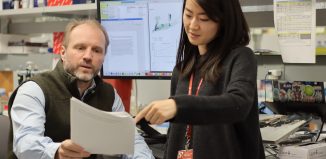Researchers find CFL bulbs can leak UV radiation
SBU professor Miriam Rafailovich and team of scientists study potential hazards of energy efficient bulbs
Miriam Rafailovich was concerned when she walked into her neighbor’s house. Her friends were putting together a jigsaw puzzle and had brought over a collection of compact fluorescent lamps (CFL) to make it easier to see the small pieces.
The Stony Brook professor of materials science and engineering urged them to use their ceiling chandelier or to look for incandescent lamps. While the energy-efficient CFL lights were helping them see, they were also likely bathing their skin in damaging ultraviolet light.
Rafailovich, who is the director of the Garcia Center for Polymers at Engineered Interfaces, learned this from her recent research. Using a broad range of CFL bulbs that junior high school students in Plainview, Syosset, Uniondale, Woodmere and Commack purchased from around Long Island, she tested the bulbs to see whether UV radiation — some of the same type emitted by the sun — was leaking out of them.
In almost every case, the protective cover around the fluorescent light had small cracks or leaks that released radiation. This confirmed what a recent European study had shown. Teaming up with Marcia Simon, the director of the Living Skin Bank at Stony Brook, Tatsiana Mironava, an adjunct faculty member and Michael Hadjiargyrou, a professor in the biomedical engineering department, Rafailovich took the European results a step further, testing the effect of this radiation on live skin cells that were grown and nurtured in a lab within a foot of the lamps to test the effect of this radiation. The light damaged the skin cells.
“We saw skin cells dying and we saw irritation,” she said. “It’s what you’d expect for cells exposed to that amount of UV rays.”
The ultraviolet exposure within a foot of CFL bulbs reached the threshold limit value (TLV — a measure of maximum dose to a specific wavelength in an eight-hour period) within 20 minutes. That means in eight hours, a person could get 17 times the maximum exposure.
“It is also important not to look into these bulbs, since UV penetrates the eye even easier than the skin,” Rafailovich contends.
Exposure to radiation at a close distance may not cause an immediate reaction because skin has an ability to adapt to UV light, the same way it would if you went to the beach every day.
“After a long time, though, you could see the effects of this exposure,” she suggested.
Based on her research, the Romanian-born Rafailovich suggests consumers should make sure CFL desk lamps have glass covers or are more than two feet away.
To be sure, the energy-efficient CFL lamps that don’t have additional glass covers are safe to use on ceilings and at greater distances. The UV radiation decreases at a rate that is the inverse square of the distance from the source. That means the further you get from the bulb, the lower the level of radiation.
Rafailovich said she has a CFL bulb in her house in Plainview and has no intention of removing it because it is far enough away that she doesn’t have to worry about radiation.
The Stony Brook professor also found that titanium dioxide, a nanoparticle (incredibly small) found in products ranging from toothpaste and tooth whiteners to some skin care products, can increase the absorption of ultraviolet radiation.
While the titanium dioxide wouldn’t necessarily be a problem for healthy skin, it could allow more absorption of the UV rays if a person had a wound.
Rafailovich’s research mission at Stony Brook includes looking at how nanoparticles more broadly affect skin cells.
When gold, which is used for imaging, is turned into a nanoparticle, it can damage cells by changing the metabolism (or burning up) of fat and will cause stem cells to differentiate differently. When it is used as a nanoparticle, titanium dioxide is even more damaging and can break the cell membrane and cause cell death.
At the same time, Rafailovich is working on ways to engineer nanoparticles for thin film coatings and biomaterials and tissue engineering.
“It’s important to have an interdisciplinary approach,” she offered.
Rafailovich has been at Stony Brook since 1994. When she was conducting her Ph.D. work, she met her husband, Jonathan Sokolov, who works in the same department. The professors have four children and five grandchildren.
Rafailovich said she enjoys Long Island for its proximity to the ocean and to New York City.






